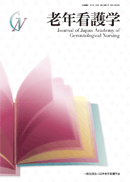Volume 22, Issue 2
Displaying 1-19 of 19 articles from this issue
- |<
- <
- 1
- >
- >|
Foreword
-
2018 Volume 22 Issue 2 Pages 3-4
Published: 2018
Released on J-STAGE: February 01, 2019
Download PDF (733K)
Special Issue: The 22nd Annual Scientific Meeting of Japan Academy of Gerontological Nursing
Presidential Address
-
2018 Volume 22 Issue 2 Pages 5-9
Published: 2018
Released on J-STAGE: February 01, 2019
Download PDF (1355K)
Special Lecture
-
2018 Volume 22 Issue 2 Pages 10-15
Published: 2018
Released on J-STAGE: February 01, 2019
Download PDF (792K)
Educational Lecture
-
2018 Volume 22 Issue 2 Pages 16-20
Published: 2018
Released on J-STAGE: February 01, 2019
Download PDF (2033K)
Symposium
-
2018 Volume 22 Issue 2 Pages 21
Published: 2018
Released on J-STAGE: February 01, 2019
Download PDF (830K) -
2018 Volume 22 Issue 2 Pages 22-24
Published: 2018
Released on J-STAGE: February 01, 2019
Download PDF (902K) -
2018 Volume 22 Issue 2 Pages 25-27
Published: 2018
Released on J-STAGE: February 01, 2019
Download PDF (1023K) -
2018 Volume 22 Issue 2 Pages 28
Published: 2018
Released on J-STAGE: February 01, 2019
Download PDF (813K) -
2018 Volume 22 Issue 2 Pages 29-30
Published: 2018
Released on J-STAGE: February 01, 2019
Download PDF (742K)
Original Articles
-
2018 Volume 22 Issue 2 Pages 31-39
Published: 2018
Released on J-STAGE: February 01, 2019
Download PDF (1305K) -
2018 Volume 22 Issue 2 Pages 40-46
Published: 2018
Released on J-STAGE: February 01, 2019
Download PDF (915K)
Brief Reports
-
2018 Volume 22 Issue 2 Pages 47-52
Published: 2018
Released on J-STAGE: February 01, 2019
Download PDF (881K) -
2018 Volume 22 Issue 2 Pages 53-59
Published: 2018
Released on J-STAGE: February 01, 2019
Download PDF (914K) -
2018 Volume 22 Issue 2 Pages 60-69
Published: 2018
Released on J-STAGE: February 01, 2019
Download PDF (1063K) -
2018 Volume 22 Issue 2 Pages 70-78
Published: 2018
Released on J-STAGE: February 01, 2019
Download PDF (1053K) -
2018 Volume 22 Issue 2 Pages 79-87
Published: 2018
Released on J-STAGE: February 01, 2019
Download PDF (1115K)
Practical Report
-
2018 Volume 22 Issue 2 Pages 88-96
Published: 2018
Released on J-STAGE: February 01, 2019
Download PDF (1334K)
Committee Activities Reports
-
2018 Volume 22 Issue 2 Pages 97-102
Published: 2018
Released on J-STAGE: February 01, 2019
Download PDF (983K) -
2018 Volume 22 Issue 2 Pages 103-107
Published: 2018
Released on J-STAGE: February 01, 2019
Download PDF (953K)
- |<
- <
- 1
- >
- >|
